University Assignment: Change Management Case Study - Analysis
VerifiedAdded on 2022/10/18
|5
|927
|13
Case Study
AI Summary
This case study examines change management within Composants Perfectionnés, a French car components manufacturer facing economic challenges. The company, with plants in France, Spain, and the UK, has traditionally focused on innovation and employee development to maintain its competitive edge. The executive board recognizes the need for significant changes, including cost-cutting measures such as production cuts and plant closures, to address the economic downturn. The analysis highlights the importance of effective communication, planning, and employee commitment in successful change management. The assignment explores the challenges in implementing change, such as resistance and poor planning, and suggests strategies to overcome these obstacles, emphasizing the need for a systematic approach, employee notification, training, and an organizational embrace of new philosophies.
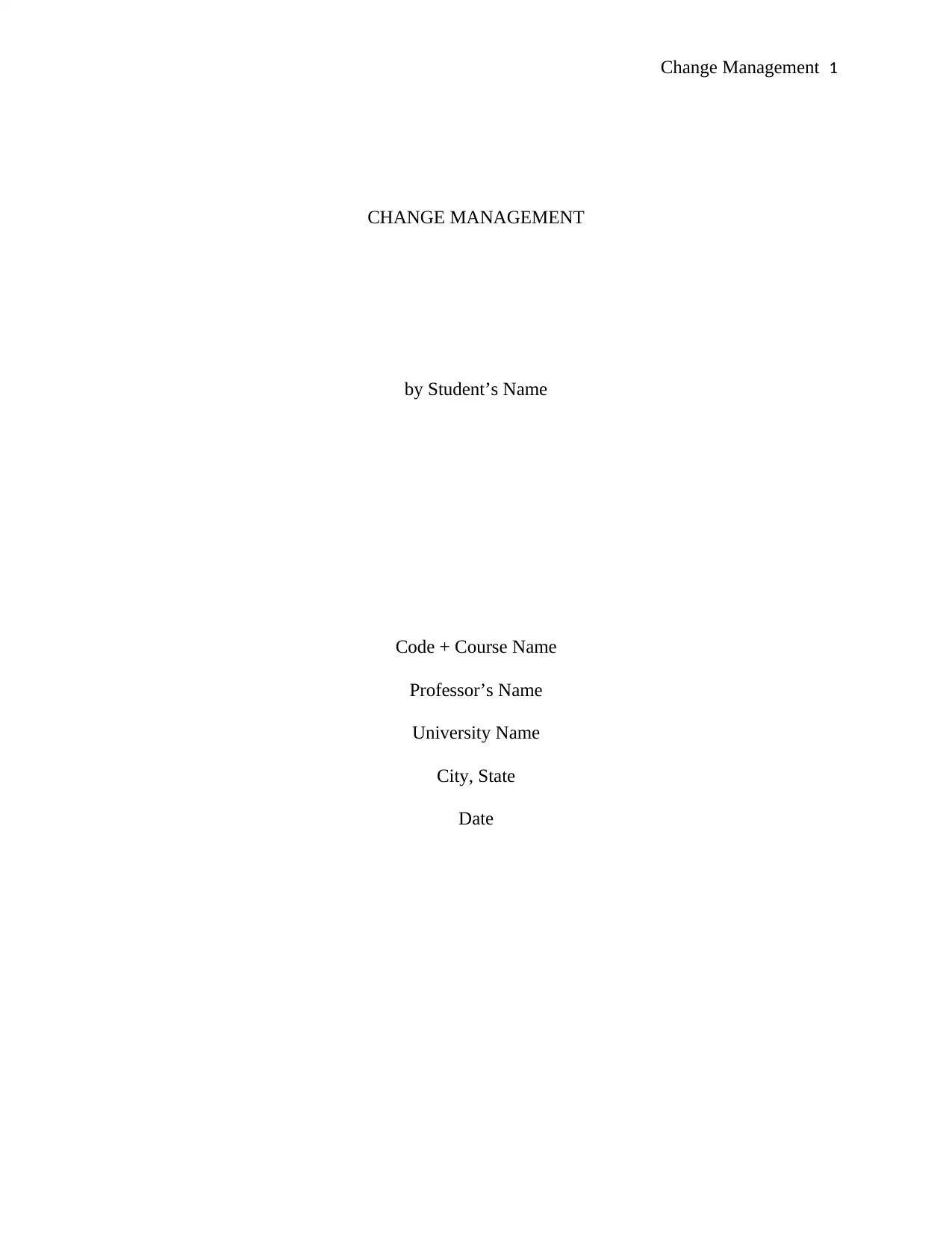
Change Management 1
CHANGE MANAGEMENT
by Student’s Name
Code + Course Name
Professor’s Name
University Name
City, State
Date
CHANGE MANAGEMENT
by Student’s Name
Code + Course Name
Professor’s Name
University Name
City, State
Date
Paraphrase This Document
Need a fresh take? Get an instant paraphrase of this document with our AI Paraphraser
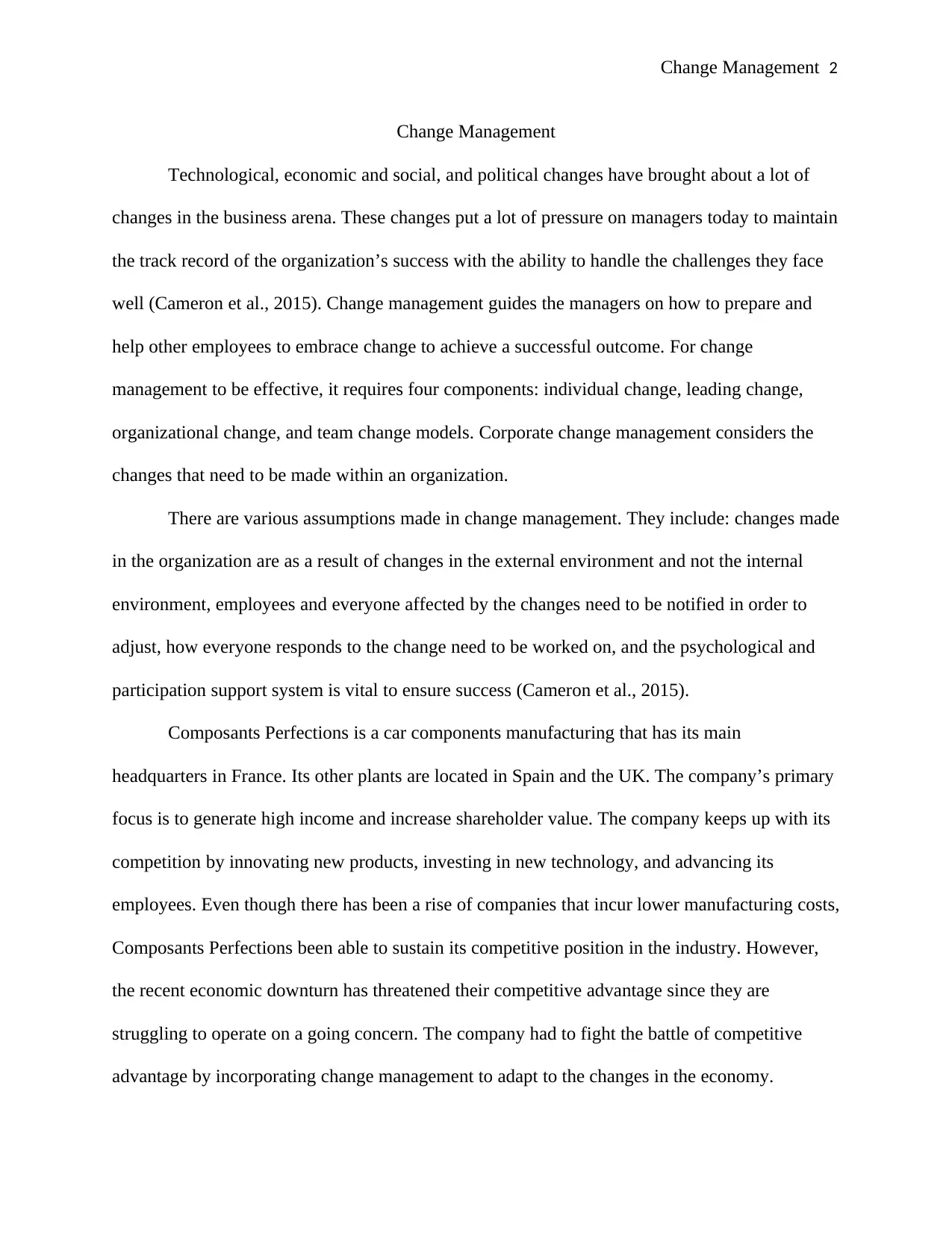
Change Management 2
Change Management
Technological, economic and social, and political changes have brought about a lot of
changes in the business arena. These changes put a lot of pressure on managers today to maintain
the track record of the organization’s success with the ability to handle the challenges they face
well (Cameron et al., 2015). Change management guides the managers on how to prepare and
help other employees to embrace change to achieve a successful outcome. For change
management to be effective, it requires four components: individual change, leading change,
organizational change, and team change models. Corporate change management considers the
changes that need to be made within an organization.
There are various assumptions made in change management. They include: changes made
in the organization are as a result of changes in the external environment and not the internal
environment, employees and everyone affected by the changes need to be notified in order to
adjust, how everyone responds to the change need to be worked on, and the psychological and
participation support system is vital to ensure success (Cameron et al., 2015).
Composants Perfections is a car components manufacturing that has its main
headquarters in France. Its other plants are located in Spain and the UK. The company’s primary
focus is to generate high income and increase shareholder value. The company keeps up with its
competition by innovating new products, investing in new technology, and advancing its
employees. Even though there has been a rise of companies that incur lower manufacturing costs,
Composants Perfections been able to sustain its competitive position in the industry. However,
the recent economic downturn has threatened their competitive advantage since they are
struggling to operate on a going concern. The company had to fight the battle of competitive
advantage by incorporating change management to adapt to the changes in the economy.
Change Management
Technological, economic and social, and political changes have brought about a lot of
changes in the business arena. These changes put a lot of pressure on managers today to maintain
the track record of the organization’s success with the ability to handle the challenges they face
well (Cameron et al., 2015). Change management guides the managers on how to prepare and
help other employees to embrace change to achieve a successful outcome. For change
management to be effective, it requires four components: individual change, leading change,
organizational change, and team change models. Corporate change management considers the
changes that need to be made within an organization.
There are various assumptions made in change management. They include: changes made
in the organization are as a result of changes in the external environment and not the internal
environment, employees and everyone affected by the changes need to be notified in order to
adjust, how everyone responds to the change need to be worked on, and the psychological and
participation support system is vital to ensure success (Cameron et al., 2015).
Composants Perfections is a car components manufacturing that has its main
headquarters in France. Its other plants are located in Spain and the UK. The company’s primary
focus is to generate high income and increase shareholder value. The company keeps up with its
competition by innovating new products, investing in new technology, and advancing its
employees. Even though there has been a rise of companies that incur lower manufacturing costs,
Composants Perfections been able to sustain its competitive position in the industry. However,
the recent economic downturn has threatened their competitive advantage since they are
struggling to operate on a going concern. The company had to fight the battle of competitive
advantage by incorporating change management to adapt to the changes in the economy.
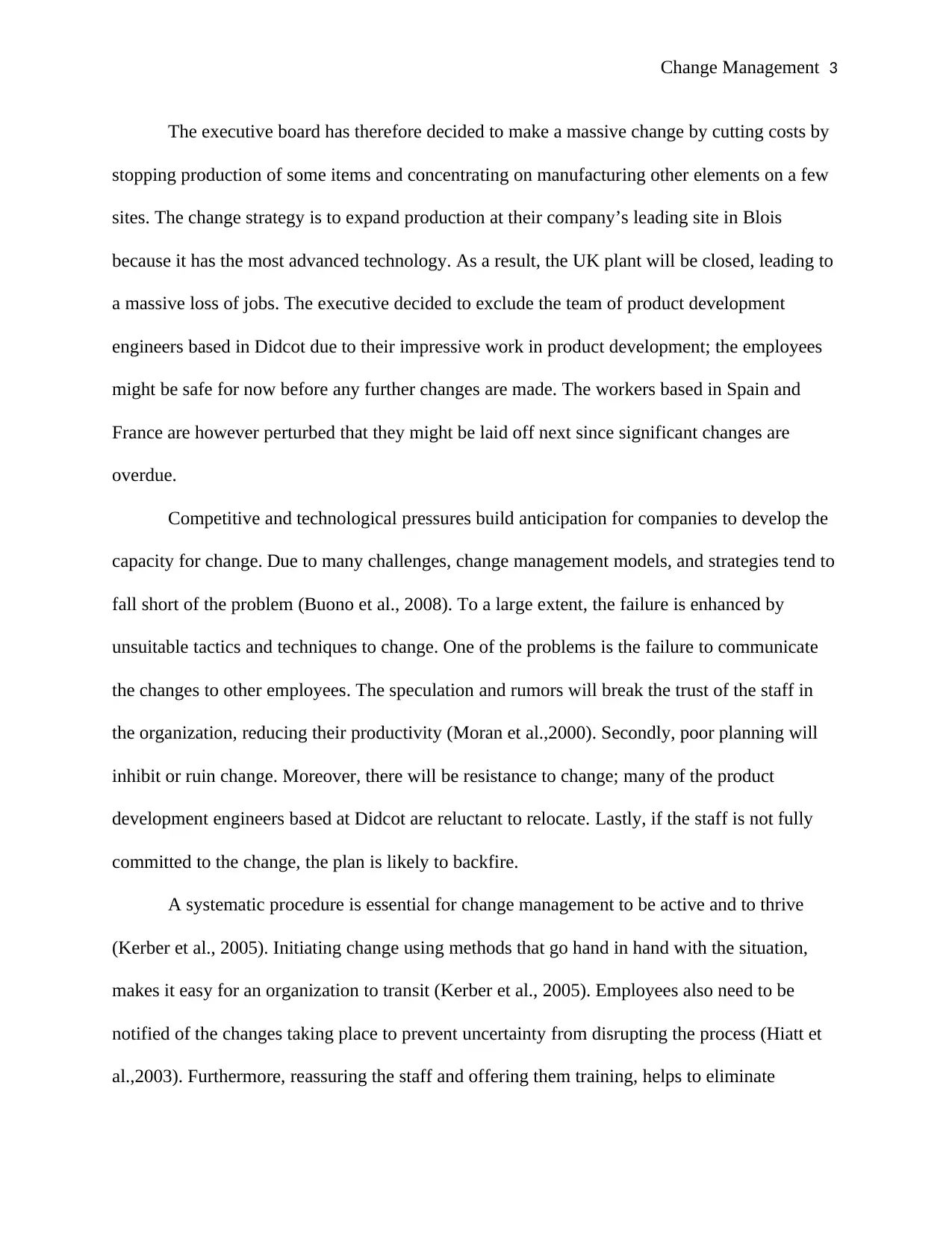
Change Management 3
The executive board has therefore decided to make a massive change by cutting costs by
stopping production of some items and concentrating on manufacturing other elements on a few
sites. The change strategy is to expand production at their company’s leading site in Blois
because it has the most advanced technology. As a result, the UK plant will be closed, leading to
a massive loss of jobs. The executive decided to exclude the team of product development
engineers based in Didcot due to their impressive work in product development; the employees
might be safe for now before any further changes are made. The workers based in Spain and
France are however perturbed that they might be laid off next since significant changes are
overdue.
Competitive and technological pressures build anticipation for companies to develop the
capacity for change. Due to many challenges, change management models, and strategies tend to
fall short of the problem (Buono et al., 2008). To a large extent, the failure is enhanced by
unsuitable tactics and techniques to change. One of the problems is the failure to communicate
the changes to other employees. The speculation and rumors will break the trust of the staff in
the organization, reducing their productivity (Moran et al.,2000). Secondly, poor planning will
inhibit or ruin change. Moreover, there will be resistance to change; many of the product
development engineers based at Didcot are reluctant to relocate. Lastly, if the staff is not fully
committed to the change, the plan is likely to backfire.
A systematic procedure is essential for change management to be active and to thrive
(Kerber et al., 2005). Initiating change using methods that go hand in hand with the situation,
makes it easy for an organization to transit (Kerber et al., 2005). Employees also need to be
notified of the changes taking place to prevent uncertainty from disrupting the process (Hiatt et
al.,2003). Furthermore, reassuring the staff and offering them training, helps to eliminate
The executive board has therefore decided to make a massive change by cutting costs by
stopping production of some items and concentrating on manufacturing other elements on a few
sites. The change strategy is to expand production at their company’s leading site in Blois
because it has the most advanced technology. As a result, the UK plant will be closed, leading to
a massive loss of jobs. The executive decided to exclude the team of product development
engineers based in Didcot due to their impressive work in product development; the employees
might be safe for now before any further changes are made. The workers based in Spain and
France are however perturbed that they might be laid off next since significant changes are
overdue.
Competitive and technological pressures build anticipation for companies to develop the
capacity for change. Due to many challenges, change management models, and strategies tend to
fall short of the problem (Buono et al., 2008). To a large extent, the failure is enhanced by
unsuitable tactics and techniques to change. One of the problems is the failure to communicate
the changes to other employees. The speculation and rumors will break the trust of the staff in
the organization, reducing their productivity (Moran et al.,2000). Secondly, poor planning will
inhibit or ruin change. Moreover, there will be resistance to change; many of the product
development engineers based at Didcot are reluctant to relocate. Lastly, if the staff is not fully
committed to the change, the plan is likely to backfire.
A systematic procedure is essential for change management to be active and to thrive
(Kerber et al., 2005). Initiating change using methods that go hand in hand with the situation,
makes it easy for an organization to transit (Kerber et al., 2005). Employees also need to be
notified of the changes taking place to prevent uncertainty from disrupting the process (Hiatt et
al.,2003). Furthermore, reassuring the staff and offering them training, helps to eliminate
⊘ This is a preview!⊘
Do you want full access?
Subscribe today to unlock all pages.

Trusted by 1+ million students worldwide
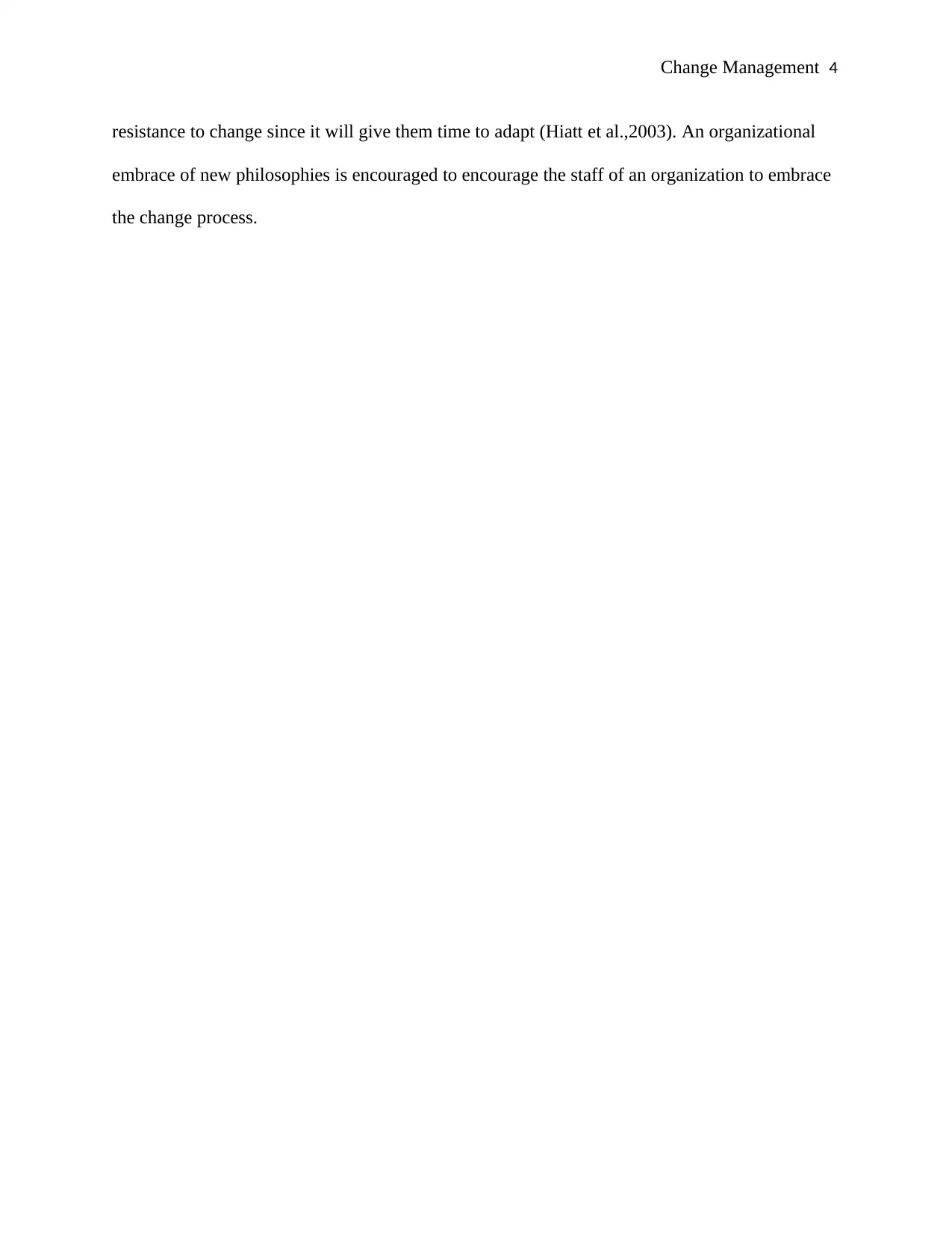
Change Management 4
resistance to change since it will give them time to adapt (Hiatt et al.,2003). An organizational
embrace of new philosophies is encouraged to encourage the staff of an organization to embrace
the change process.
resistance to change since it will give them time to adapt (Hiatt et al.,2003). An organizational
embrace of new philosophies is encouraged to encourage the staff of an organization to embrace
the change process.
Paraphrase This Document
Need a fresh take? Get an instant paraphrase of this document with our AI Paraphraser
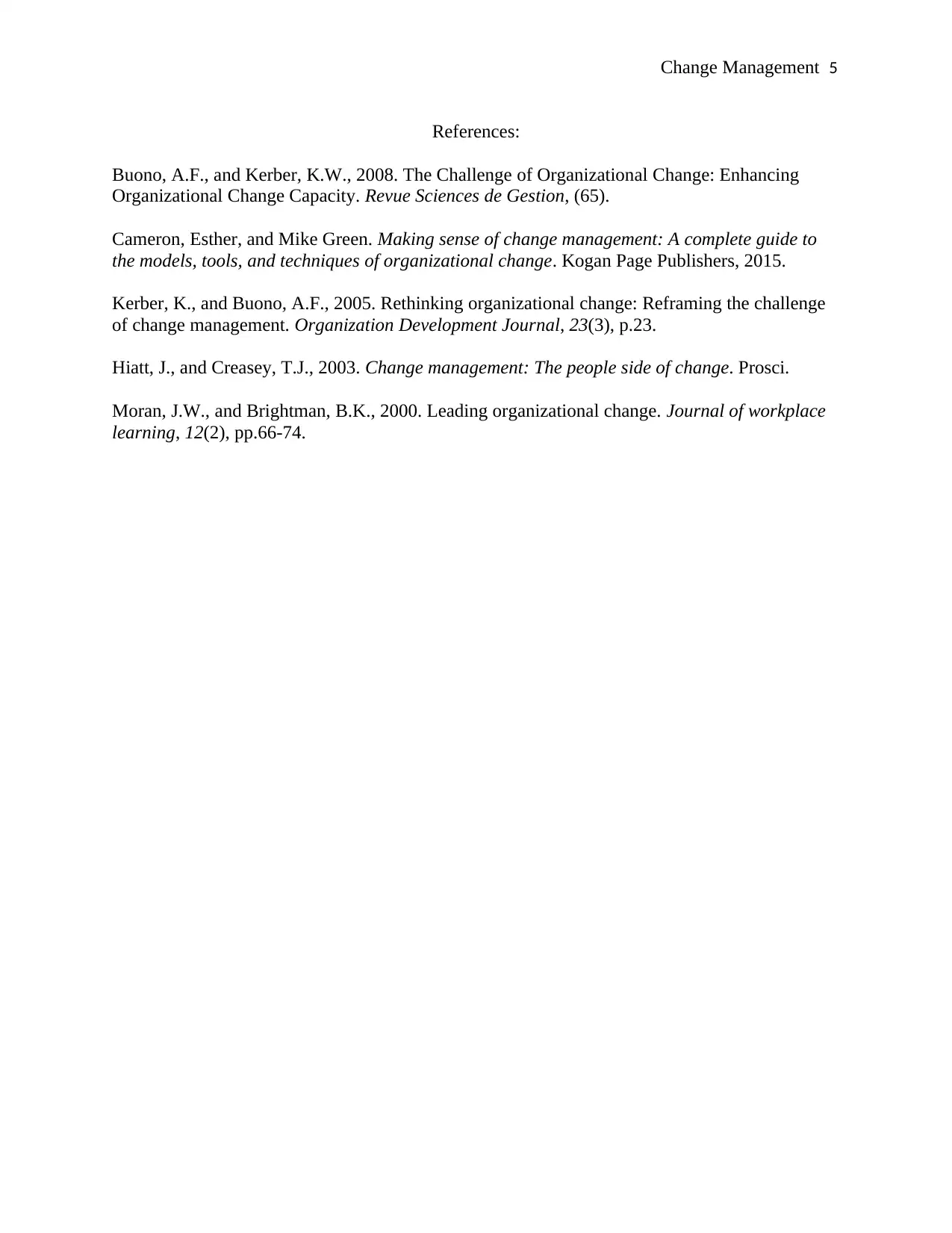
Change Management 5
References:
Buono, A.F., and Kerber, K.W., 2008. The Challenge of Organizational Change: Enhancing
Organizational Change Capacity. Revue Sciences de Gestion, (65).
Cameron, Esther, and Mike Green. Making sense of change management: A complete guide to
the models, tools, and techniques of organizational change. Kogan Page Publishers, 2015.
Kerber, K., and Buono, A.F., 2005. Rethinking organizational change: Reframing the challenge
of change management. Organization Development Journal, 23(3), p.23.
Hiatt, J., and Creasey, T.J., 2003. Change management: The people side of change. Prosci.
Moran, J.W., and Brightman, B.K., 2000. Leading organizational change. Journal of workplace
learning, 12(2), pp.66-74.
References:
Buono, A.F., and Kerber, K.W., 2008. The Challenge of Organizational Change: Enhancing
Organizational Change Capacity. Revue Sciences de Gestion, (65).
Cameron, Esther, and Mike Green. Making sense of change management: A complete guide to
the models, tools, and techniques of organizational change. Kogan Page Publishers, 2015.
Kerber, K., and Buono, A.F., 2005. Rethinking organizational change: Reframing the challenge
of change management. Organization Development Journal, 23(3), p.23.
Hiatt, J., and Creasey, T.J., 2003. Change management: The people side of change. Prosci.
Moran, J.W., and Brightman, B.K., 2000. Leading organizational change. Journal of workplace
learning, 12(2), pp.66-74.
1 out of 5
Related Documents
Your All-in-One AI-Powered Toolkit for Academic Success.
+13062052269
info@desklib.com
Available 24*7 on WhatsApp / Email
![[object Object]](/_next/static/media/star-bottom.7253800d.svg)
Unlock your academic potential
Copyright © 2020–2025 A2Z Services. All Rights Reserved. Developed and managed by ZUCOL.





